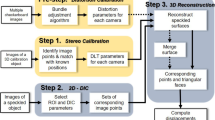Abstract
Mechanical structures such as automobiles, building structures, ships, etc., are exposed to vibration under operating conditions. Especially under resonance, small excitations cause large deformation of structures, which is directly related to human safety. Modal testing is a method by which the dynamic properties of structures under vibrational excitation can be determined. A modal testing system can be utilized in a variety of applications and ways, depending on the sensor that measures vibration. Recently, numerous studies in the field of noncontact measurement techniques have been carried out. Among the developed approaches, vision-based vibration measurement has the important advantage that the displacement response of a whole region, not a point or a line, can be measured at one time. However, the measurement using a camera has a problem in that the sampling rate is insufficient as compared with the conventional contact-type sensor. The sampling rate is determined by the limited frame rate of the camera hardware, and modes above the Nyquist frequency cannot be measured according to the Nyquist theorem. In response, in this research, we propose a phase axis-based vibration measurement method instead of the conventional time axis-based vibration measurement method using time-phase transformation. In order to apply the proposed method, among the various excitation methods used in modal testing, we utilize the excitation method of changing the single excitation frequency stepwise. The single frequency excitation method has a feature that the response frequency is equal to the frequency of the excitation signal when the response of the excited system reaches a steady state. Using this feature together with time-to-phase transformation, we can perform modal testing in the hyper-Nyquist frequency range, which was previously impossible to measure. Finally, a simple experiment on a beam confirmed the validity of the proposed method.
Access this chapter
Tax calculation will be finalised at checkout
Purchases are for personal use only
Similar content being viewed by others
References
Ewins, D.J.: Modal testing: Theory and practice. Research Studies Press, Letchworth (1984)
Gloth, G., Sinapius, M.: Analysis of swept-sine runs during modal identification. Mech. Syst. Signal Process. 54(4), 1421–1441 (2004)
Choi J.: A study on visual modal analysis using dynamic moire method. KAIST Master thesis (2016)
Li, W., Su, X., Liu, Z.: Large-scale three-dimensional object measurement: A practical coordinate mapping and image data-patching method. Appl. Opt. 40, 3326–3333 (2001)
Acknowledgments
This work was supported by the Brain Korea 21 Plus Project.
Author information
Authors and Affiliations
Corresponding author
Editor information
Editors and Affiliations
Rights and permissions
Copyright information
© 2021 Springer Nature Switzerland AG
About this paper
Cite this paper
Kim, D., Park, Y. (2021). Vision-Based Modal Testing of Hyper-Nyquist Frequency Range Using Time-Phase Transformation. In: Oberst, S., Halkon, B., Ji, J., Brown, T. (eds) Vibration Engineering for a Sustainable Future. Springer, Cham. https://doi.org/10.1007/978-3-030-48153-7_8
Download citation
DOI: https://doi.org/10.1007/978-3-030-48153-7_8
Published:
Publisher Name: Springer, Cham
Print ISBN: 978-3-030-48152-0
Online ISBN: 978-3-030-48153-7
eBook Packages: EngineeringEngineering (R0)




